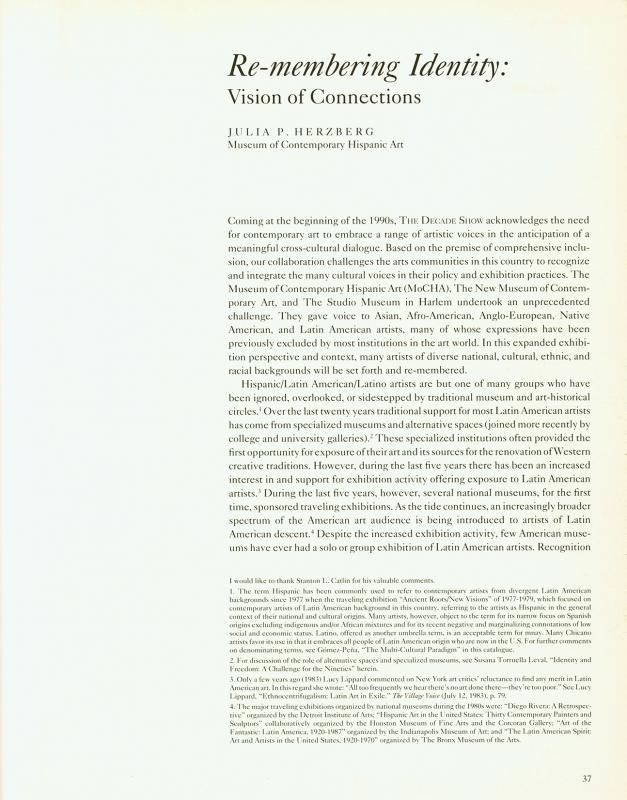Julia P. Herzberg is an art historian, independent curator, and Fulbright Senior Specialist living in New York. She completed her PhD in art history at the Graduate Center, City University of New York, in 1998, with a dissertation on Cuban artist Ana Mendieta. She is a specialist of Latin American artists living in the United States, and has curated more than twenty-five exhibitions. Herzberg was a co-curator of The Decade Show (1990), held in New York at the Museum of Contemporary Hispanic Art, the New Museum, and the Studio Museum in Harlem, and she was the curator of the official U.S. representation for the III Bienal Internacional de Pintura in Cuenca, Ecuador (1991). In addition to serving as a consulting curator at El Museo del Barrio in New York (1996–2001), she was a consulting curator for the 2003, 2006, and 2009 Bienales de La Habana, and she is a contributing and consulting editor for Arte al día Internacional. Herzberg has taught, lectured, and published extensively in the United States and abroad and received two J. William Fulbright Scholarship Board awards: one at the Pontificia Universidad Católica (2007) and another at the Universidad Diego Portales (2013), both in Santiago, Chile, and also served as a visiting professor at the Instituto de Arte, Pontificia Universidad Católica de Valparaíso, Chile (2016).
The artists included in the biennial’s U.S. representation are roughly part of the same generation and were living in the United States at the time of the exhibitions. Cándida Alvarez (b. 1955, Brooklyn, New York) is a painter of Puerto Rican descent currently based in Chicago. She is known for her complex combination of abstract and figurative forms that draw on a range of popular, historical, and Modern art references. Luis Cruz Azaceta (b. 1942, Havana, Cuba), left his country as a teenager, eventually moving to New York, where he is currently based. His mixed-media art practice addresses themes from urban violence, AIDS, and racism, to terrorism, geographic displacement, and economic collapse. Josely Carvalho (b. 1942, São Paulo, Brazil) is a multidisciplinary artist living between New York and Rio de Janeiro. Her early work in printmaking has developed into a mixed-media practice that engages social and political issues. Ismael Frigerio (b. 1955, Santiago, Chile) studied philosophy and painting in Chile before moving to New York in 1982 (returning back to Chile in the early 1990s). Influenced by Neo-Expressionism, his paintings present metaphors on anatomy and topography. Juan González (b. 1942, Camaguey, Cuba; d. 1993, New York), a hyperrealist painter who lived between Miami and New York after immigrating to the United States from Cuba, created Surrealist dreamscapes that often involve subtle and allegoric queer subtexts. He died in New York of AIDS-related causes. “Nuyorican” artist Juan Sánchez (b. 1954, Brooklyn, New York) is known for his large-scale, layered mixed-media collage paintings, though his work has evolved to include photography, printmaking, and video installations, all addressing issues of race, class, cultural identity, equality, and social justice.
The Bienal Internacional de Pintura in Cuenca, Ecuador, held its first edition in 1987. It was originally dedicated entirely to painting, and it followed a national representation system. Today, it is no longer solely for painting and, since 2011, it no longer follows the national representation model. It continues to emphasize Latin American art, but not exclusively. [As a complementary reading, see another 1990 text in the ICAA Digital Archive focused on several of the artists included in this show: “Re-Membering Identity: Vision of Connections” (doc. no. 1343879), written by Julia P. Herzberg.]

